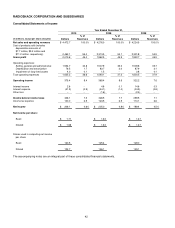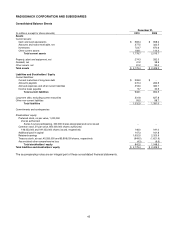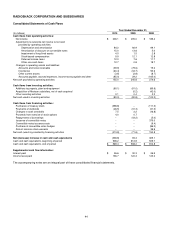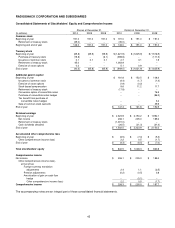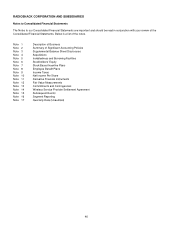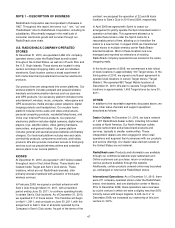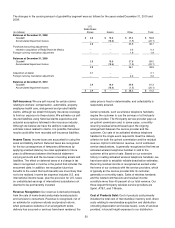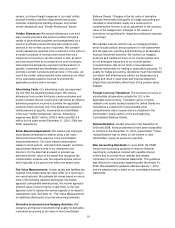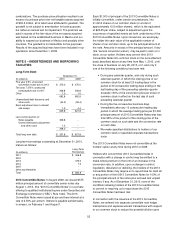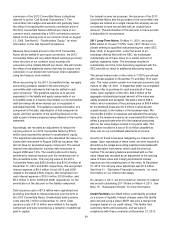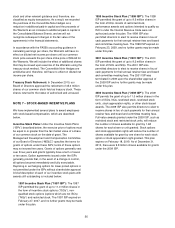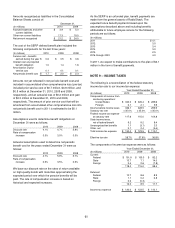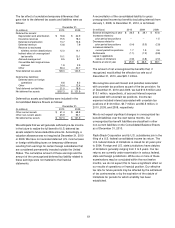Radio Shack 2010 Annual Report Download - page 61
Download and view the complete annual report
Please find page 61 of the 2010 Radio Shack annual report below. You can navigate through the pages in the report by either clicking on the pages listed below, or by using the keyword search tool below to find specific information within the annual report.51
centers, out-bound freight expenses to our retail outlets,
physical inventory valuation adjustments and losses,
customer shipping and handling charges, and certain
vendor allowances (see “Vendor Allowances” below).
Vendor Allowances: We receive allowances from third-
party service providers and product vendors through a
variety of promotional programs and arrangements as a
result of purchasing and promoting their products and
services in the normal course of business. We consider
vendor allowances received to be a reduction in the price of
a vendor's products or services and record them as a
component of inventory until the product is sold, at which
point we record them as a component of cost of products
sold unless the allowances represent reimbursement of
specific, incremental and identifiable costs incurred to
promote a vendor's products and services. In this case, we
record the vendor reimbursement when earned as an offset
to the associated expense incurred to promote the
applicable products and/or services.
Advertising Costs: Our advertising costs are expensed
the first time the advertising takes place. We receive
allowances from certain third-party service providers and
product vendors that we record when earned as an offset to
advertising expense incurred to promote the applicable
products and/or services only if the allowances represent
reimbursement of specific, incremental and identifiable
costs (see “Vendor Allowances” above). Advertising
expense was $206.1 million, $193.0 million and $214.5
million for the years ended December 31, 2010, 2009 and
2008, respectively.
Stock-Based Compensation: We measure all employee
stock-based compensation awards using a fair value
method and record this expense in the consolidated
financial statements. Our stock-based compensation
relates to stock options, restricted stock awards, and other
equity-based awards issued to our employees and
directors. On the date that an award is granted, we
determine the fair value of the award and recognize the
compensation expense over the requisite service period,
which typically is the period over which the award vests.
Fair Value Measurements: Certain assets and liabilities are
required to be measured at fair value either on a recurring or
non-recurring basis. We estimate fair values based on one or
more of the following valuation techniques: the market
approach (comparable market prices), the income approach
(present value of future income or cash flow), or the cost
approach (cost to replace the service capacity of an asset or
replacement cost). See Note 12 - “Fair Value Measurements”
for additional disclosures of our fair value measurements.
Derivative Instruments and Hedging Activities: We
recognize all financial instruments that qualify for derivative
instrument accounting at fair value in the Consolidated
Balance Sheets. Changes in the fair value of derivative
financial instruments that qualify for hedge accounting are
recorded in stockholders’ equity as a component of
comprehensive income or as an adjustment to the carrying
value of the hedged item. Changes in fair values of
derivatives not qualifying for hedge accounting are reported
in earnings.
We maintain internal controls over our hedging activities,
which include policies and procedures for risk assessment
and the approval, reporting and monitoring of all derivative
financial instrument activities. We monitor our hedging
positions and creditworthiness of our counter-parties and
do not anticipate losses due to our counter-parties’
nonperformance. We do not hold or issue derivative
financial instruments for trading or speculative purposes. To
qualify for hedge accounting, derivatives must meet defined
correlation and effectiveness criteria, be designated as a
hedge and result in cash flows and financial statement
effects that substantially offset those of the position being
hedged.
Foreign Currency Translation: The functional currency of
substantially all operations outside the U.S. is the
applicable local currency. Translation gains or losses
related to net assets located outside the United States are
included as a component of accumulated other
comprehensive (loss) income and are classified in the
stockholders’ equity section of the accompanying
Consolidated Balance Sheets.
Reclassifications: Certain amounts in the December 31,
2009 and 2008, financial statements have been reclassified
to conform to the December 31, 2010, presentation. These
reclassifications had no effect on net income or total
stockholders’ equity as previously reported.
New Accounting Standards: In June 2009, the FASB
issued new accounting guidance to improve financial
reporting by companies involved with variable interest
entities and to provide more relevant and reliable
information to users of financial statements. This guidance
was effective for fiscal years beginning after November 15,
2009. We adopted this guidance effective January 1, 2010,
and the adoption had no effect on our consolidated financial
statements.



